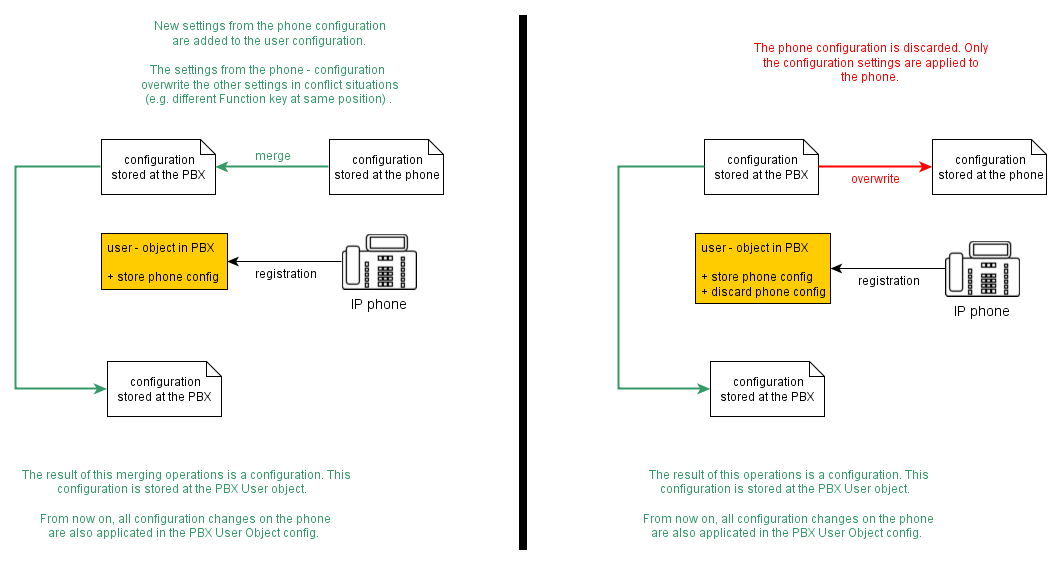Howto:Merging of phone configs stored in the PBX
Applies To
This information applies to
- innovaphone PBX Systems V8 and up
More Information
Problem Details
Traditionally, phone configurations used to be stored on the respective phones directly. While this is easy and convenient, it turns out to be a problem when many phones need to be managed. Often, similar settings shall be applied to several phones, which is difficult and error prone to do. Also, when a phone is replaced, its configuration needs to be restored from a recent backup.
This is why parts of the phone configuration can be stored in the PBX. To enable this feature, tick the Store Phone Config check-mark in the user object's User configuration tab. You will then find a link config in the Phone column of the PBX's tab. The phone configuration is now shown both in the PBX's configuration UI (by clicking on the config link) and the phone's configuration UI.
Normally, any existing configuration on a phone is retrieved and saved in the PBX's phone configuration. However, it is possible to discard any phone configuration. See the Store Phone Config and Discard Config on Phone properties for more details.
Phone configurations can also be stored in configuration templates . If a configuration template includes a phone configuration and this template is assigned to a PBX (User) object, the user will inherit the phone configuration from the template.
If the user itself has a phone configuration stored in the PBX, the template's and the user's configuration are merged and then applied to the actual phone.
Finally, a configuration template can inherit up to 4 other configuration templates. This can be used recursively, so that a template tree can be built.
This article will explain how the merging of config settings stored at different PBX objects(config template and user object) works works.
Resolution
Lets assume that we have a setup, with phone config settings stored in Config Templates, at a user object and in the phone. The graphic below describes the merging process.
In this case there are more Config Templates nested and by this we created a template tree. The Special User template is then assigned to our PBX user object. Because, in our example, all this objects have a stored phone config, the merging process is started.
- First the phone configs of the config templates are merged. Settings that don't overlap/conflict in both templates are combined and stored in the resulting config file. In case of conflicting settings (e.g. different function key at same position), the resulting config file will include only the settings defined in the nested template(child template in template tree).
- Now the combined config file is merged with the config stored at the PBX user object. Te merging is similar to the previously described process, the only difference is that now the PBX user object settings have precedence over the template settings.
- Finally, if the resulting config file has 'Store Phone Config' activated and 'Discard Config on Phone' deactivated , the config settings stored in the registered phone are merged with the current config settings stored at PBX user object. Now the config settings stored at the phone have precedence. If also 'Discard Config on Phone' is activated the phone configuration is not included in the resulting, final config file of the PBX user object.
- Now there is one config file for this specific User object. The configuration at the registered phone and the configuration stored in the PBX is equal. If a change is made on either side(i.e. PBX or phone), the change is applied at the phone as well as in the config stored at the PBX.
- If a change is made in the template, the merging process is done as previously described.
Known Problems
As already described, the 'Discard Config on Phone' setting is used when initially merging the PBX user object config with the config stored at the registered phone. Afterwards, users can make config changes at their phone or in the PBX.
The role of 'Discard Config on Phone' is often misunderstood, people tend to believe that it will hinder users to make configuration changes by using their phone. As said before, this is not true. If such a setup is needed, the administrator must enable function locking or function hiding at the phone.
